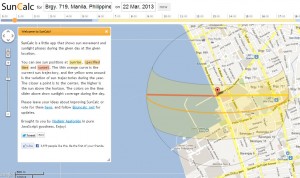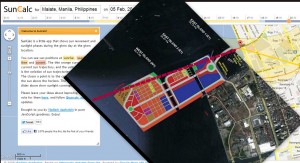I was informed rather belatedly that Neophyte Congressman Douglas Hagedorn, the brother of former Puerto Princesa Mayor Edward Hagedorn, has gone on ahead and stated his opposition to a proposed reclamation project in Manila Bay.
As the Vice Chairman of the House Committee on Ecology, Hagedorn has cited the following reasons for opposing the project in an article on Manila Times:
- Manila’s local ordinance cannot supersede a Presidential Proclamation, much more overrule Republic Act 7586, or the National Integrated Protected Areas System Act of 1992, Republic Act 10066 or the National Cultural Heritage Act and Republic Act or the Strengthening People’s Nationalism Through Philippine History Act.
- Resolution No. 19, s. 2012, of the National Historical Commission which declares the Manila Bay and water front, from Del Pan to the Cultural Center of the Philippines, as a national historical landmark protected by laws.
- Those opposed to the project, however, claim that the initiative will block the famous spectacular sunset view by the Manila Bay, may cause more flooding, risks liquefaction during earthquakes, among others
It seems Hagedorn was just recently informed of the Manila Solar City Reclamation project but not enough of the answers to the rehashed issues against the reclamation project — all of which have been answered by the proponents before.
| SUPPORT INDEPENDENT SOCIAL COMMENTARY! Subscribe to our Substack community GRP Insider to receive by email our in-depth free weekly newsletter. Subscribe to our Substack newsletter, GRP Insider! Learn more |
It would be quite unfortunate for Manila’s 11 million citizens if Hagedorn succeeds in scuttling a project that would provide for 200,000 jobs as well as an additional P30 Billion in revenues that will fund the city governments continued operation and plans for redevelopment.
But just briefly, here are a couple of key points addressing those rehashed issues.
With regard to the supposedly legal issues against the proposed construction of the Manila Solar City, all these issues were answered when the Philippine Reclamation Authority allowed reclamation on the site behind the Cultural Center of the Philippines.
Moreover, one point worth discussing at length is whether the National Commission for Culture and the Arts or the National Historical Institute has any authority to impede the City of Manila from embarking on a project that would provide a source of much need funds for the city’s redevelopment and social services. As early as August 2012, former Manila Mayor Alfredo Lim, under whose term the city had first overturned a previous disapproval of the reclamation project, the COA had reported that Manila was in deep debt;
In the latest report uploaded on its website, the COA said the Manila city government has unpaid debts of P3.553 billion, or more than three times its cash holdings of P1.006 billion.
State auditors said Manila’s payroll exceeded the mandatory spending limit of 45 percent of the total annual income from regular sources realized in the preceding fiscal year.
The COA estimated that Manila should have forked out only P2.458 billion in 2011 based on its P5. 462 billion income in 2010.
But the city actually shelled out P3.424 billion in salaries and retirement benefits, on top of the P260.95 million in “financial assistance” it gave to its officials and employees.
Manila continues to be saddled in debt and trying to continue funding the services needed by its millions of residents, prompting former President now Manila Mayor Joseph Estrada to reaffirm the need for the city to undertake the Manila Solar City Reclamation project as a means of creating additional revenue streams for the city.
“Right now, the study shows that Manila has the most number of jobless people. A hungry stomach knows no law. So we can eliminate criminality,” Manila Mayor Joseph Estrada said.
A recent article on the boon of the Manila Solar City, Philippine Star Columnist Domini Torrevillas notes:
After all, as soon as the reclamation is completed, within two years, the national government will own 30.52 hectares worth P30.5 billion, and the city of Manila will own five hectares of buildable area worth P5 billion. Edmund said when the Manila Solar City is fully developed, Manila will have a real estate tax base of P113 billion for land, and P580 billion for built-up properties, plus business permits and license fees. And the employment potential, continued Edmund, is from 250,000 to 500,000 jobs,in creasing a larger business and income tax base.
With regard to supposed environmental damage that will be wrought by the construction of the reclamation project, the proponents of the project have already undertaken public scoping which determined that no significant environmental damage would take place. Moreover, the court of appeals has allowed reclamation in another part of Manila Bay that had been opposed on environmental grounds by the Villars and in that decision, the court threw out the Villar’s petition saying it had not proven that substantial environmental damage would occur.
Here’s an excerpt of that article:
The latest CA ruling penned by Associate Justice Apolinario Bruselas Jr. said the senator did not raise new arguments in her petition to justify a change in the court’s earlier ruling.
“After a careful assessment…, we find the same to be a rehash of the issues and arguments raised in the petition and which have already been passed upon in our decision,” the court division said, noting that Villar “failed to raise new matters” in her motion for reconsideration.
Last year, Villar asked the Supreme Court to stop the reclamation project to be undertaken by Al Tech Contractors Inc. as this might impede the natural river flow in her city in Las Piñas, destroy the remaining 175-ha mangrove forest and marine habitat in Las Piñas and Parañaque, and cause flooding in many villages. The mangrove and marine habitat is known as the Las Piñas-Parañaque Critical Habitat and Ecotourism area.
On the issue that the reclamation site would block Manila Bay’s sunset, the good congressman would be best advised by using www.suncalc.net, this is website that plots the sun path in the sky as it would be seen from different points on the ground. The website scientifically shows that the sun sets at different points in the horizon during different months of the year and the closest it will be to setting near the Manila Solar City reclamation project will be in March. During the rest of the year, the sunset on Manila Bay either in the middle of the bay and towards the Manila harbor.
Here is a screen capture of the suncalc website’s graphic on the sun’s path over Manila.
Here is the suncalc website’s graphic on the sun’s path over the Manila Solar City.
As for the danger of earth quakes arising from a “fault” supposedly discovered by Dr. Rodolfo, this was soundly debunked by Phivolcs:
“These pictures from the satellite are only half of the story. It’s only good when it can be verified through studies conducted on the ground,” he said (referring to Dr. Kelvin Rodolfo, the geologist who inferred from satellite imagery that there was a new fault).
“[Dr.] Mahar Lagmay and his staff are doing a study which is still ongoing and funded by the DOST,” he added.
Lagmay is the head of the DOST’s multibillion-peso Project Noah (Nationwide Operational Assessment of Hazards), a two-year flood forecasting and warning system. A University of the Philippines (UP) professor, he earned his doctorate in Earth Sciences from the University of Cambridge.
—
“We [saw] the same thing they [did] but we did not interpret it the same way. We didn’t find any evidence of a new fault,” Renato Solidum said.
According to him, a very careful evaluation of data was required for any such conclusions to be made. Solidum noted that the presence of the West Valley Fault was “very obvious” to seismologists unlike the supposed new fault.
In determining if there really was a new fault in Metro Manila, he said the next question to ask would be if this fault was active, and if active, whether it could cause a major earthquake.
Metro Manila, Solidum noted, was both a plateau and a delta, the former being a buildup of sturdy rocks, and the latter referring to a place where sand is deposited.
“This means there’s soft ground and hard ground. So we have to be certain. We have to be able to explain if the ground is subsiding or uplifting,” he said.
“If indeed there’s a major fault, it must be associated with a major earthquake. Some people are confused if you say there is a fault because you have to ask, ‘Is it active?’” Solidum added.
He said that Phivolcs scientists had also observed subsidence in a “central part of Metro Manila” applying the same technology Rodolfo used but they did not make the same inferences.
Further more, the number of earthquakes which affected Manila from the one that caused the collapse of the ruby tower to the 1990 earthquake, no liquefaction happened on Roxas Boulevard — THE ENTIRE LENGTH OF WHICH IS BUILT ON RECLAIMED LAND.
On the issue that the Manila Solar City will cause more flooding through a bowl effect. This is premised on a gross misunderstanding of what the bowl effect is. This occurs usually when the downward gradation of land towards the sea or body of water is cut off completely. The Manila Solar City will not create a bowl effect because (1) it does not cover the entire mouth of Manila bay and (2) it is not built on a flood path according to the DOST Project Noah.
Moreover, the real cause of flooding in the area where Manila Solar City will be built is the seasonal storm surge — where the sea rises above its usual levels and dumps water on land.
A storm surge is an offshore rise of water associated with a low pressure weather system, typically tropical cyclones and strong extra-tropical cyclones. Storm surges are caused primarily by high winds pushing on the ocean’s surface.
The structure would serve as an additional barrier to the ocean, thus preventing or diffusing sea water from rushing along Roxas Blvd.

Writer.


Hey Paul,
The cynic in me tends to believe that the motivations of Filipino politicians have in embarking on a crusade like this fall into one of two categories. First, it’s pure and simple extortion. Another greedy bastard out to get his share of the pie hoping the high degree of public exposure will make him difficult to ignore. Second, he’s already been paid off by (business/political) rivals of the project who want to destroy any possibility of it getting started and this is one of their attacks. Kind of like ABS-CBN TV/radio personality Ted Failon’s phony, over-the-top campaign against the West Cove resort in Boracay.
I’ll give Congressman Hagedorn the benefit of doubt and assume that he hasn’t gotten enough information about the project as of yet.
Then there’s the issue of Carlos Celdran, who supposedly is against Solar City.
But wait, didn’t Mayor Estrada want Celdran to be an advisor? If so, Celdran would have to become a turncoat and SUPPORT Solar City.
I don’t know what to make of it, but the irony is so delicious.
It isn’t only politicians who can be paid off.
Please stick to the issue: The “prejudicial question” of Cong. Hagedorn: “Is the Solar City project legal?” What law can you cite that allows it? A mere city ordinance cannot supersede a national law. After this (and other) “prejudicial” or basic issues are resolved, then — and only then — could we proceed to consider the economic and other aspects of the proposed project.
Hi Dodgie,
The Philippine Reclamation Authority approved the project under its national mandate as stated in PD1085. The question really is whether Congressman Hagedorn is challenging the authority of PRA.
Hi, Paul!
Marcos’ PD 1085 (circa 1977) seems irrelevant here. Please carefully read PD 1085. Said decree merely conveyed (already) reclaimed land to PEA. You may not agree with me that more recent laws and national policy effectively clipped PEA (now PRA)’s authority. What is stopping the proponents to ask President Aquino to submit a certified urgent measure to Congress, for the latter to settle the prejudicial legal question?
Dodjie, I have to admit that I am not really an expert on the laws cited here and I am just citing what I read in the briefing papers on the project.
As far as the project is concerned, the fact is that it was approved by the PRA and if there is an issue of its powers being “clipped”, then that should perhaps be raised in court.
So far, the groups who have raised issues against Manila Solar City have not filed a case in court to settle the matter. The issues they raised were rather superficial and easily debunked, i.e., that the reclamation project would block the sunset, that it would cause environmental damage, that it would cause more flooding, etcetera.
As for NIPAS, the particular site is not identified as part of any protected area.
As for the National Heritage Act, the problem with its proclamation is that it seems to cover the entire Manila Bay and which case, why is Manila Solar City being singled out?
I think more important that the abstract value of historical conservation is the need to provide Manila’s residents with economic opportunities and its city government with much needed revenues that will support its social services.
I hope that such bids for historical conservation doesn’t come at the expense of dire, present needs of the citizens of Manila.
I do hope that Congressman Hagedorn will keep an open mind regarding the merits of this project.
By the way, are you Congressman Dodgie Osabel of the Alagad Party List?
MAYBE the political wrangling should cease and desisit and the gov’t. should hire a foreign firm to come in and actually do something to correct the distressful and disgusting cesspool problem that has become Manila Bay? u kno, hire someone w/no horse in the race, pay them squarely to do a job that desperately needs to be done. Hiring another local? Will get the Manila Bay more contamination and pollution. When will the people who run the country realize that Mother Earth is getting fed-up with her ill-treatment at the hands of the ants?
no to corporate greed! no to solar city!!! it will destroy the aquatic life of manila bay!!!
No to dumbasses and hypocritical, classes douchebags.
They are the ones who are killing the Failippines. 😛
And no to anti-progress commietards like you. You’re just a cancer to the society that needs to be eradicated. You hate corporate greed? Then you better stop paying your monthly electricity and internet bills for posting your whinefest here you utak squatter.
Are you HIGH? What the frick are you talking about? Aquatic life? You mean the barnacles and sea-cockroaches?
Yes, Paul, I am the founding president of ALAGAD, and I represented the Party in the 11th and 14th Congress. The issue about existing law and current policy going in conflict with a local ordinance or PRA cannot be ignored. Surely, a project this huge, requires a thorough examination. After the legal hurdle, we can then look at the environmental, social, economic and other aspects. Don’t you think so?
Yes, I agree that if there is any issue with the PRA’s authority, it should be raised in court and not in Congress.
However, in my view, the legal issue is the lesser consideration.
What I think is more important is the fact that Manilenyos NEED that reclamation project for the many reasons I’ve cited in my article.
Mayor Erap had voiced his support for the project saying that “A hungry stomach knows no law.”
Perhaps your cousin, Congressman Hagedorn, should look beyond the scant legal basis for his opposition — which I have been told was already deliberated upon not only by the City Council of Manila but by the Supreme Court and Court of Appeals as well.
Paul, you can help educate your readers, us included, if you cite the SC and CA rulings that you mentioned. Let us not rely on hearsay … Let us read and weigh things ourselves, and welcome opposing views. We are not opposed to progress, provided it is legal, ecologically sustainable, economically feasible, socially acceptable and inclusive, and properly located. I am sure Solar City would be welcome in Zambales or in Pangasinan, and even more economic as reclamation is not necessary. Come to think of it, Manila is not the Philippines, and the Philippines is not Manila, and progress should be dispersed not concentrated — so that people would stop migrating to Manila. “A hungry stomach knows no law?” Good grief!